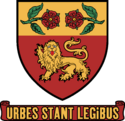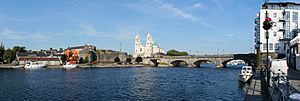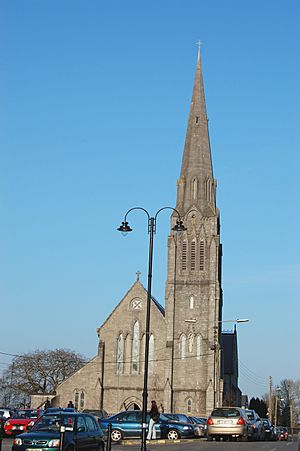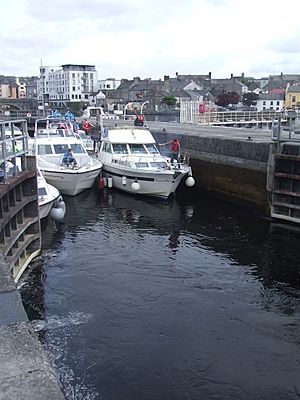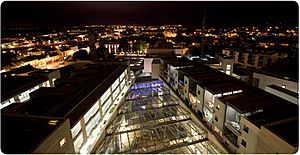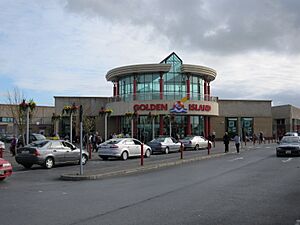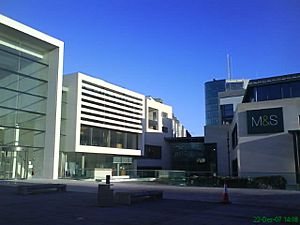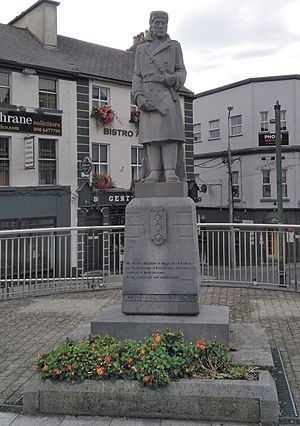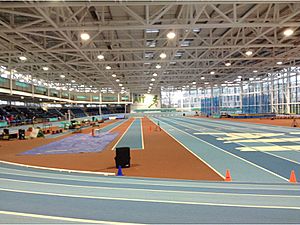Athlone facts for kids
Quick facts for kids
Athlone
Baile Átha Luain
|
||
|---|---|---|
|
Town
|
||
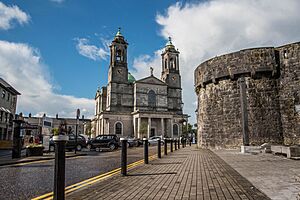
From centre: the Church of Saints Peter and Paul sits on the bank of the River Shannon; Athlone Castle
|
||
|
||
| Motto(s):
Latin: Urbes Stant Legibus
"A city stands by its laws" |
||
| Country | Ireland | |
| Province | Leinster, Connacht | |
| County | County Westmeath, County Roscommon | |
| Area | ||
| • Total | 10.92 km2 (4.22 sq mi) | |
| Elevation | 56 m (184 ft) | |
| Population
(2022)
|
||
| • Total | 22,869 | |
| • Density | 2,094.2/km2 (5,424.0/sq mi) | |
| Time zone | UTC±0 (WET) | |
| • Summer (DST) | UTC+1 (IST) | |
| Eircode routing key |
N37
|
|
| Telephone area code | +353(0)90 | |
| Irish Grid Reference | N033420 | |
Athlone (pronounced "ath-LONE") is a town in Ireland. It sits right on the border between County Roscommon and County Westmeath. The town is built along the River Shannon, which is Ireland's longest river, and is close to the southern part of Lough Ree, a large lake.
Athlone is the second biggest town in the Midlands area of Ireland. In 2022, about 22,869 people lived there. Most of Athlone is on the east side of the River Shannon. However, some parts on the west side, which used to be in County Roscommon, were made part of County Westmeath in 1898. This was done to keep the town together.
Athlone is special because it's very close to the exact middle of Ireland. It's about 100 kilometers (62 miles) west of Dublin, the capital city.
Contents
History of Athlone
Athlone Castle, located on the west bank of the River Shannon, is a very old and important part of Athlone. For a long time, the spot where Athlone is now was important because it had a "ford" (a shallow place to cross a river). South of Athlone, the Shannon River was too deep to cross easily until you reached Clonmacnoise. To the north, the river flows into Lough Ree.
In the year 1001, a famous Irish leader named Brian Boru sailed his army up the river to Athlone. The next year, he met another powerful leader, Máel Sechnaill mac Domnaill, in Athlone. Máel Sechnaill gave up his title as High King without a fight.
A bridge was built across the river in the 1100s. To protect this bridge, a fort was built in 1129 by High King Tairrdelbach Ua Conchobair. The fort and bridge were often attacked. Later, around 1210, the Anglo-Normans built a stronger stone castle. The tall, 12-sided tower you see today is from that time. However, much of the original castle was destroyed during a big battle called the Siege of Athlone in 1691. It was then rebuilt and made bigger.
In 1607, Athlone was given a special charter by King James I. This allowed the town to send two people to the Irish Parliament.
During the wars in Ireland in the 1600s, Athlone was very important. It had the main bridge over the River Shannon into the western part of Ireland called Connacht. In the Irish Confederate Wars (1641–1653), Irish troops held the town until 1650.
Later, during the Williamite War in Ireland (1688–1691), Athlone was again a key place. After the Battle of the Boyne in 1690, Athlone was one of the strongholds protecting the river crossings into the Jacobite-held area of Connacht. In 1690, Jacobite forces in Athlone successfully defended against a large attack.
The next year, in 1691, there was another, bigger attack known as the Siege of Athlone. The invading army of King William and Queen Mary eventually took over the city. The defenders had to run away quickly, even throwing their cannons into the mud. A letter found in 2004, written by the winning general, said that nearly 2,000 defenders died in the city.
After the Acts of Union 1800, Athlone continued to send one person to the British Parliament until 1885.
Location and Travel
Athlone is unique because the River Shannon divides it. The part of town east of the river is in County Westmeath and the province of Leinster. The part west of the river, even though it's surrounded by County Roscommon (in the province of Connacht), is still part of County Westmeath. This helps keep the town connected.
There are many churches in Athlone, including St. Mary's (Catholic and Church of Ireland) and the St. Peter and St. Pauls.
River Travel
Athlone is a popular stop for boats traveling on the River Shannon. Lough Ree, the biggest lake on the Shannon, is just a short distance upstream. Many boat companies operate from Athlone. To pass through Athlone, boats use a special "lock" in the river. This lock, along with a weir (a small dam) and the road bridge, was built in the 1840s. Before that, boats used a canal that was built in the 1750s.
Train Travel
Athlone railway station opened in 1859. From here, you can travel by train east to Dublin Heuston and west to places like Westport and Galway. You can also connect to other towns like Limerick, Cork, and Waterford by changing trains at certain stations.
Bus Travel
Bus Éireann used to offer frequent bus services from Athlone to Dublin and Galway. However, these routes were stopped in 2021. Now, private companies like Citylink and Aircoach provide bus services from Athlone to Galway, Dublin city, and Dublin airport. These buses stop at places like Arcadia Retail Park and Athlone Institute of Technology.
There are also bus services to other towns like Limerick, Dundalk, and Cavan. Athlone also has local bus services run by Bus Éireann, which became Ireland's first fully electric bus service in January 2023.
Road Travel
Athlone is located next to the M6 motorway, which connects Galway to Dublin. Other main roads, like the N55, N61, and N62, connect Athlone to other towns and regions in Ireland.
Town Government
Athlone was given the right to govern itself by King James I in 1607. This meant it could elect people to the Irish Parliament. Over time, the way Athlone was governed changed. In 2014, like all town councils in Ireland, Athlone's town council was ended.
Today, Athlone is part of local government areas in both Roscommon County Council and Westmeath County Council. The modern Athlone Civic Centre, a new building for local government, was finished in 2004.
Culture and Arts
Athlone has a lively arts scene. It has two theatres: the Dean Crowe Theatre & Arts Centre and the Little Theatre.
Every year, Athlone hosts the RTÉ All-Ireland Drama Festival. This event brings together amateur drama groups from all over Ireland. There are also "fringe" events like street theatre, art shows, and workshops for young people.
The Athlone Literary Festival is an annual event that started in 1999. It celebrates writers and features many speakers and debates.
The famous singer John McCormack was born in Athlone. For many years, a festival was held in town to celebrate his life.
The Athlone School of Music opened in 2005. It helps develop music education in the Midlands area.
Abbey Road Artists' Studios opened in 2011. These studios provide a space for local and visiting artists to work. They also host cultural events, exhibitions, and workshops. The studios work closely with the Luan Art Gallery.
In 1954, Athlone became the first branch of the Inland Waterways Association of Ireland, an organization that helps protect and promote Ireland's waterways.
Literature Connections
Athlone is mentioned in books! The American crime writer James M. Cain wrote about Athlone in his 1937 book, Serenade. In the book, characters discuss how the famous singer John McCormack was from Athlone and how people there speak English beautifully.
The Irish poet Aubrey Thomas de Vere wrote a poem called The Ballad of Athlone. It tells the story of an event during the 1691 siege of the town.
Shopping and Fun
Athlone is a great place for shopping in the Midlands. The town centre has many shops. The Athlone Town Centre is a large shopping mall built in 2007 with 54 shops, cafes, and a hotel. The Golden Island Shopping Centre also opened in the town centre in 1997.
The Athlone Regional Sports Centre, built in 2002, is on the edge of town. It has a swimming pool, a gym, and sports pitches.
Athlone also has many hotels, including well-known chains like Radisson Blu and Sheraton, as well as local hotels.
Places to Visit
The promenade along the River Shannon is a nice place for fishing, birdwatching, and swimming. You can reach the lake from Coosan Point and Hodson Bay.
Athlone Castle is open to the public as a museum, where you can learn about its history. There's also a tourist office nearby. Sean's Bar, on the west side of the river, is famous for being the oldest pub in Ireland!
The Luan Gallery opened in 2012. It's a modern art gallery, the first of its kind in the Midlands. It was designed by Keith Williams, who also designed the Athlone Civic Centre.
Burgess Park is a lovely park near the town centre, right on the River Shannon. Other fun places nearby include the Glendeer Open Farm and the Viking Cruise on the Shannon. Baysports, a water sports centre with the world's largest floating inflatable water slide, is located at Hodson Bay.
Public Art
Around Athlone, you can see different sculptures. There's an IRA Memorial on Custume Place, put up in the 1950s. It's a statue of a man in an old army uniform. Also on Custume Place is a sculpture called the "Mask of the Shannon," which represents the River Shannon. Another statue on St. Mary's Square celebrates the contributions of the Marist Brothers to Athlone.
Greenway
The Old Rail Trail greenway is a path for cycling and walking that runs for 42 kilometers (26 miles) from Athlone to Mullingar. It follows an old railway line. This greenway will eventually be part of a bigger path connecting Dublin to Galway. A new bridge for bikes and walkers over the River Shannon opened in August 2023, right next to the Luan Gallery.
Education and Jobs
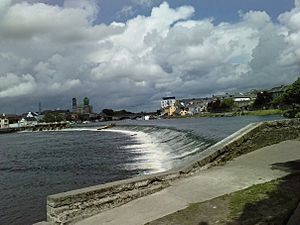
Athlone has many important employers. Some big companies here include Alkermes and Bioclin Laboratories (pharmaceuticals), Ericsson (telecommunications), Tyco Healthcare and Utah Medical (medical equipment), and Alienware (computer hardware).
Athlone is also a center for many government and semi-government organizations. The Department of Education, the State Examinations Commission, and Bus Éireann all have offices here. Athlone is also a major military center, with the Custume Barracks serving as the headquarters for the Western Command of the Irish Army.
The Technological University of the Shannon: Midlands Midwest (TUS) has a campus in Athlone. It has modern buildings for hospitality, nursing, engineering, and research. The campus also hosts RTÉ's Midlands studio. TUS has partnerships with universities in other countries like Brazil, China, Saudi Arabia, and India.
There are four main secondary schools in Athlone: Athlone Community College (mixed), Our Lady's Bower School (girls), Marist College (boys), and Coláiste Chiaráin (a new school formed by combining two older schools).
Radio and News
From 1931 to 1975, Athlone was home to the main radio transmission center for Irish radio. The station was known as "Radio Athlone" and could be heard across Europe. Many old radios even had "Athlone" marked on their tuning dials.
Today, RTÉ's Midlands studios are in Athlone. The local radio station is Midlands 103. There's also i102-104FM, which started in 2008 for younger listeners, and Athlone Community Radio, which began broadcasting in 2008 and received a 10-year license in 2011.
For local news, you can read the Westmeath Independent newspaper, which started in 1846, or the Athlone Topic.
Sports in Athlone
Athlone is a great place for sports! It has the Athlone Regional Sports Centre.
The town is home to Athlone Town Football Club, who play their games at Athlone Town Stadium. The club won the League of Ireland Championship in 1981 and 1983, and the FAI Cup in 1924. They even played against the famous AC Milan team in 1975!
The Athlone IT International Arena, which cost ten million Euro, opened in 2013. It's Ireland's first "world-class" indoor athletics arena and hosts big events like the annual AIT Grand Prix.
Athlone hosted the European Triathlon Championships in 2010, with about 5,000 athletes taking part.
Athlone also has several Gaelic football teams, including Tubberclair GAA, Garrycastle GAA, and Athlone GAA. Garrycastle GAA reached the All-Ireland Senior Club Football Championship final in 2012.
The town is also home to Buccaneers RFC, a rugby club whose grounds are at Dubarry Park. This stadium can hold 10,000 people and is also home to the Connacht Eagles rugby team.
The Lough Ree Yacht Club is also based in Athlone.
In 2013, Athlone was named the European Town of Sport. There are also several golf courses near Athlone, such as Athlone Golf Club.
Famous People from Athlone
Many notable people have connections to Athlone, including:
- John Broderick, a novelist.
- Robbie Henshaw, an Irish rugby player.
- Henry Kelly, a journalist and TV presenter.
- John McCormack, a world-famous singer.
- Mary O'Rourke, a politician and author.
- Seán McLoughlin, a popular YouTube game commentator.
- Brendan Shine, a folk/country singer.
International Connections
Athlone has friendly connections with other towns around the world:
 Athlone, Victoria, Australia
Athlone, Victoria, Australia- Chateaubriant, France
See also
 In Spanish: Athlone para niños
In Spanish: Athlone para niños


